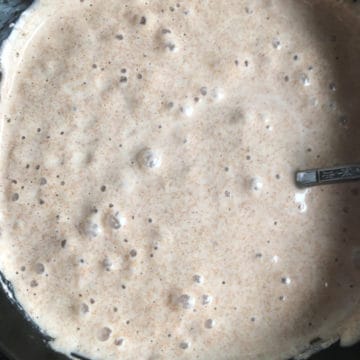
Spelt Flour Sourdough Starter Recipe for Bread
Can you use spelt flour for sourdough starter? Yes! This easy spelt flour sourdough starter recipe requires only two simple ingredients.
Ingredients
- spelt flour
- water
Want to Help?If you love this recipe, please come back and leave a rating. This helps readers and I'd love to hear from you. Thank you ❤️
Instructions
- Day 1: Combine ½ cup of spelt flour with ¼ cup of lukewarm water in a bowl that you won’t need for a few days. Cover the container with a paper towel, parchment paper, or a clean dish towel and leave it at room temperature (70°F/21°C) for 24 hours. Don't use an airtight lid on the container.
- Day 2: The next day, measure out ¼ cup of starter and discard the rest. Mix the reserved starter with ½ cup spelt flour and ¼ cup lukewarm water. Cover the bowl again with a towel and let it rest at approximately 70°F (21°C) for another 24 hours.
- Days 3-5: The spelt starter should be bubbly and have that characteristic sourdough smell. Starting on day 3, feed the starter twice per day (12 hours apart), once in the morning and once at night. For each feeding, mix ¼ cup of the starter with ½ cup of spelt flour and ¼ cup of lukewarm water. Then you should cover the bowl loosely and let it rest at 70°F (21°C) until the next feeding.
- Day 6: The starter should be bubbly and smell like sourdough. If it is not as active as described, continue feeding it for another couple of days before continuing on. When the starter looks and smells like it is ready, you can use it in bread recipes!
- Sourdough Starter Storage: Keep sourdough flour spelt starter in the fridge in a loosely lidded mason jar between feedings. At least once per week, remove your starter from the fridge and let it come to room temperature. Remove ¼ cup of starter and discard the rest. Mix this reserved starter in a bowl with ½ cup of flour and ¼ cup of water. Let it sit at room temperature for 6-8 hours until it gets nice and bubbly, and then pop it back in the fridge. Don't cover the canning jar or crock tightly.
- To Make Bread from Refrigerated Starter: Remove the starter from the refrigerator and let it come to room temperature. Measure out ¼ cup of starter. Feed the starter it with ½ cup of flour and ¼ cup of water and then let it rest at room temperature (70°F/21°C). Continue feeding it every 12 hours until you are ready to use the starter in your recipe. You should have fed the starter at least 3 times before you use it. This gives your starter plenty of time to become bubbly and active, so your bread will rise well. If you need a large amount of starter in your recipe, don’t discard starter for the last few feedings.
- Hot tip! Get sourdough starter discard ideas, a link to a sourdough bread recipe, and additional tips for caring for your starter in the article above.
Notes
💭 Expert Tips from Dietitian Summer Yule
This is a level 3 recipe (weight maintenance and active lifestyles). Many find bread and other baked goods made with flour to be extremely easy to overeat. Thus, I’m placing this spelt sourdough starter recipe at level 3. Making sourdough bread may not be the best option for some people. This includes those who are trying to follow a low-carb diet and those who have identified bread as a personal trigger food. (A trigger food is a food that someone has a great deal of trouble *not* overeating.) I am not saying that everyone who wishes to lose weight must skip bread. However, it is important to be especially mindful of the portion size with bread. One-fourth cup of flour, about the amount in one thin bread slice, provides 100-110 calories. Whole grain breads are not lower calorie options (unless they are special high fiber “diet” breads). I know I’m not alone in being able to eat 3-4 (or more!) delicious slices of homemade bread in a sitting. If you’ll be using your spelt sourdough starter to make bread weekly, you can freeze extra, or share it. Friends and neighbors may appreciate a warm loaf of your homemade sourdough bread. It makes a fantastic gift! Nutrition information is for ¼ cup of spelt flour sourdough starter.
nutrition info disclaimer
All recipes on this website may or may not be appropriate for you, depending on your medical needs and personal preferences. Consult with a registered dietitian or your physician if you need help determining the dietary pattern that may be best for you.
The nutrition information is an estimate provided as a courtesy. It will differ depending on the specific brands and ingredients that you use. Calorie information on food labels may be inaccurate, so please don't sweat the numbers too much.
"To taste" means to your preferences, which may have to be visual to follow food safety rules. Please don't eat undercooked food x
Nutrition
Calories: 100kcalCarbohydrates: 18gProtein: 4gFat: 0.5gPotassium: 115mgFiber: 3gIron: 8% DV